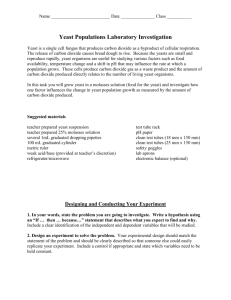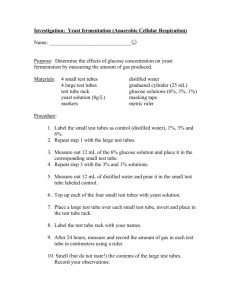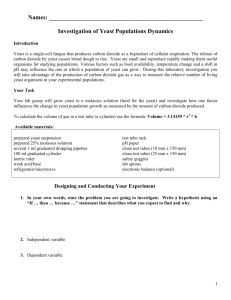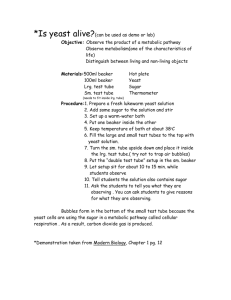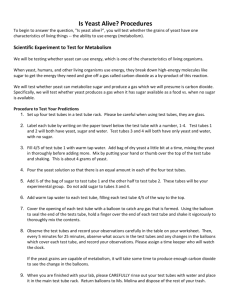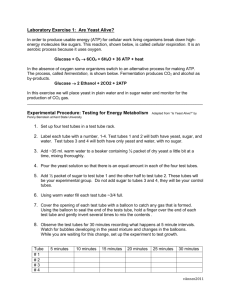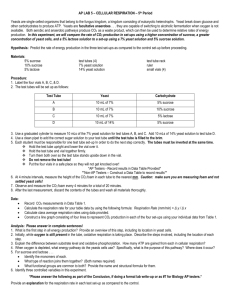Yeast and Molasses Lab Report
advertisement
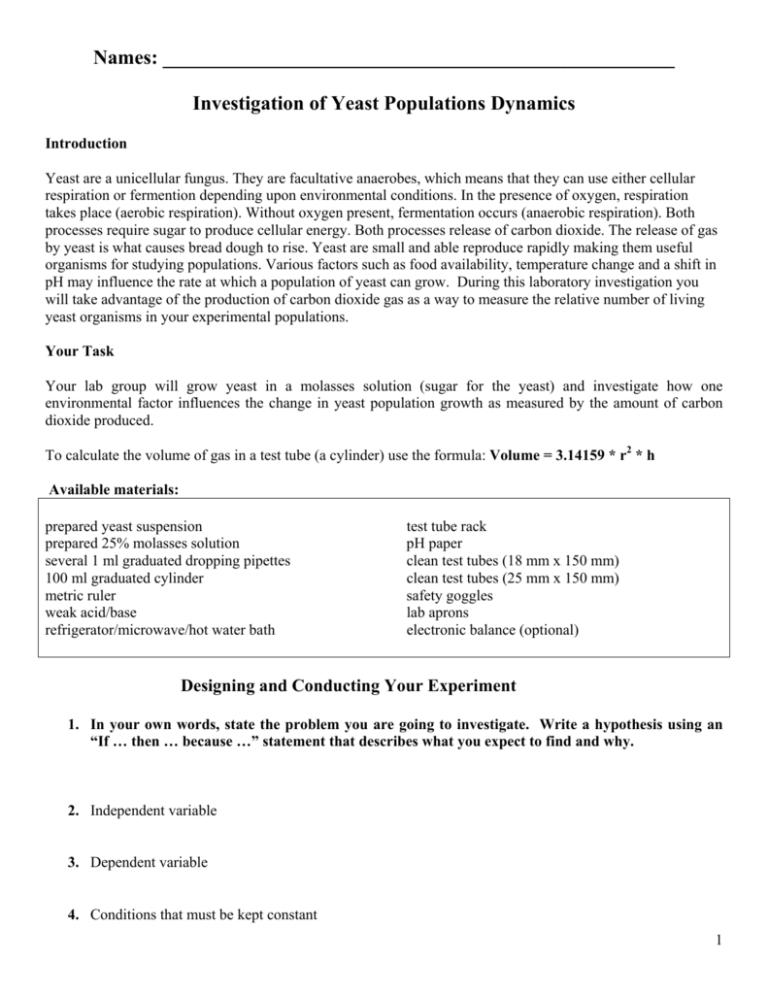
Names: ___________________________________________________ Investigation of Yeast Populations Dynamics Introduction Yeast are a unicellular fungus. They are facultative anaerobes, which means that they can use either cellular respiration or fermention depending upon environmental conditions. In the presence of oxygen, respiration takes place (aerobic respiration). Without oxygen present, fermentation occurs (anaerobic respiration). Both processes require sugar to produce cellular energy. Both processes release of carbon dioxide. The release of gas by yeast is what causes bread dough to rise. Yeast are small and able reproduce rapidly making them useful organisms for studying populations. Various factors such as food availability, temperature change and a shift in pH may influence the rate at which a population of yeast can grow. During this laboratory investigation you will take advantage of the production of carbon dioxide gas as a way to measure the relative number of living yeast organisms in your experimental populations. Your Task Your lab group will grow yeast in a molasses solution (sugar for the yeast) and investigate how one environmental factor influences the change in yeast population growth as measured by the amount of carbon dioxide produced. To calculate the volume of gas in a test tube (a cylinder) use the formula: Volume = 3.14159 * r2 * h Available materials: prepared yeast suspension prepared 25% molasses solution several 1 ml graduated dropping pipettes 100 ml graduated cylinder metric ruler weak acid/base refrigerator/microwave/hot water bath test tube rack pH paper clean test tubes (18 mm x 150 mm) clean test tubes (25 mm x 150 mm) safety goggles lab aprons electronic balance (optional) Designing and Conducting Your Experiment 1. In your own words, state the problem you are going to investigate. Write a hypothesis using an “If … then … because …” statement that describes what you expect to find and why. 2. Independent variable 3. Dependent variable 4. Conditions that must be kept constant 1 Before Designing Your Experiment Review This General Procedure For Growing Yeast: 1. Label the smaller test tubes using masking tape near the closed end. 2. Measure the diameter of your smaller test tubes and record. 3. Place 25 ml of the 25% molasses solution into one of the small test tubes. 4. Stir the yeast suspension and then place 2 ml of the yeast suspension into the same test tube. 5. Place the test tube in the rack. 6. Place your thumb or palm over the open end of the small test tube and slowly invert (flip) it. 7. Wait for the air bubble to rise to the top (well technically the bottom which is now at the top). 8. Repeat the inversion five times. 9. Hold the test tube with the yeast mixture upright (open end up). 10. Have your partner carefully slide a larger tube down over the smaller tube. 11. Use your finger to support the bottom of the yeast test tube while holding the outer (larger) test tube. 12. Quickly invert the tubes so that the tube with the yeast mixtures is upside down and the mouth of the large tube is facing up. 13. Using a metric ruler measure the height of the air bubble (mm or cm) at the top of the smaller tube and record on your data table. 14. Carefully place the test tubes in the beaker or rack. Do not disturb the air bubble 15. Repeat and modify steps for your other test tubes 16. Allow the sample to ferment for 25 minutes. 17. While waiting calculate the volume of the starting bubble using the formula V = 3.14159 * r2 * h 18. Measure the bubble and record the change in the size due to carbon dioxide gas production on your data table. (To find the change in size subtract the initial gas bubble size from the total bubble size.) 2. Design an experiment by modifying the above procedure by adding steps where necessary to test your specific environmental factor. Your experimental design should match your statement of the problem and should be clearly described so that someone else could easily replicate your experiment. Include a control group and state which variables need to be held constant. 2 Draw your laboratory apparatus. Label each part. Design your data tables and describe what observations you will need to make. When you have completed your design and data tables call your teacher to check your work for possible safety violations. 4. Conduct your experiment. While conducting your experiment, take notes and organize your data into tables. Safety note: You must wear approved safety goggles and follow all safety instructions. When you have finished, your teacher will give you instructions for cleanup procedures, including proper disposal of all materials 3 Communicating Your Findings – Lab Report Outline Working as individuals, summarize your work in a laboratory report that includes the following: A statement of the problem you investigated. A hypothesis (“If ... then … because …” statement) that described what you expected to find and why. Include a clear identification of the independent and dependent variables. A description of the experiment you carried out. Your description should be clear and complete enough so that someone could easily replicate your experiment. Data from your experiment. Your data should be organized into tables, charts and/or graphs as appropriate. Your conclusions from the experiment. Your conclusions should be fully supported by your data and address your hypothesis. The change in the height of the gas bubbles The change in the volume of the gas bubbles Discuss the reliability of your data and any factors that contribute to a lack of validity of your conclusions. Include ways that your experiment could be improved if you were to do it again. Type your lab report. Be sure to complete the evaluation rubric on the next page and include it as the last page of your lab report 4 Molasses and Yeast Lab Report Rubric Student Name: Due Date: If the task has been completed, all points are awarded. If the task is incomplete half points may be awarded. No points are awarded if the task is not complete. Category Scoring Criteria Points Student Teacher Evaluation Evaluation 3 3 3 3 Procedures reflect what you actually did, written in paragraph form 7 Lab procedure is detailed and complete (no missing steps). 3 Measurements show proper units. 2 A before diagram of all of your test tubes. Bubble height is labeled. 3 An after diagram of all of your test tubes. Bubble height is labeled. 3 Group Data Table – height|volume at start|finish, change in height|volume 3 A bar graph of your results for change in bubble size (CM) 3 A bar graph of your change in bubble VOLUME (CM3) 3 The graphs properly display all of your data 5 On graph paper (or printed), used ruler, title, units and headings 5 Summarize the lab data. (come to a conclusion) 10 Show how the data answers the lab question from the introduction. 15 Discuss the reliability of your data and any factors that contribute to a lack of validity of your conclusions. 5 Last sentence restates the final conclusion 5 Report is printed in black ink on white paper using 12 point font. Paragraphs are double spaced with 1 inch margins on all sides with no visible corrections. (it is ok to draw your diagrams) 5 Presentation A diagram of the lab apparatus used in the experiment is drawn in the 15 points largest available white space on the front of the lab report (or cover). 5 Report is written so that other students could accurately duplicate the experiment. 5 5 Total Points 104 The question to be answered during the lab is stated. Lab The hypothesis is correctly written and supported with facts. Introduction 12 points An explanation of yeast and fermentation. A brief summary of your experimental approach Methods 10 points Results 17 points Graphs 10 points Discussion 35 points Participation No group members were cited for safety or participation violations. 5 points Score Self‐ evaluation Deadline If the difference between the student evaluation and the teacher evaluation is less than 5 points, 5 points will be added to the teacher's score when the grade is recorded. Reports turned in after the beginning of class on the due date will lose 15 points. 5
